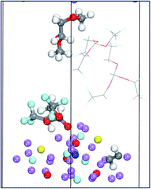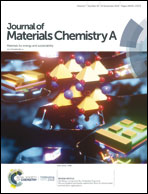Localized high concentration electrolyte behavior near a lithium–metal anode surface†
Abstract
Wide-scale practical application of rechargeable lithium–metal batteries remains a significant challenge due to dendrite growth. To overcome this challenge, electrolytes must be designed to allow for the formation of protective solid electrolyte interphase (SEI) layers on the highly reactive lithium–metal anode (LMA) surfaces. Recently, novel localized high-concentration electrolytes (LHCEs) were introduced as a potential solution to enable dendrite-free cycling of LMAs, by using an inert solvent to “dilute” the high concentration electrolytes. Ideally, the diluent itself does not dissolve the salt but is miscible with the solvent to form a localized high concentrated salt/solvent cluster surrounded by the diluent. However, detailed structure and potential surface reactions that may take place in LHCE environment are not yet clear. In this work, we investigated the reactivity of 1 M lithium bis(fluorosulfonyl)imide (LiFSI) in a mixture of dimethoxyethane (DME)/tris(2,2,2-trifluoroethyl)orthoformate (TFEO) (1 : 3 by mol) electrolyte near a Li metal surface based on density functional theory and ab initio molecular dynamics (MD) simulations. Selected liquid interfacial configurations were obtained from classical MD simulations. Our results indicate that when salt and TFEO molecules are close to each other and to the surface, fluoride anions resulting from the fast salt anion decomposition can trigger a cascade of reactions that lead to the decomposition of TFEO. However, if the Li cation is initially solvated by DME and the anion forming a complex, the stability of the anion increases significantly. The Li solvated structure is implied in the LHCE concept; however statistically the larger amount of TFEO molecules suggest also the first scenario leading to TFEO decomposition. Therefore, the broader implication of our simulations is that the defluorination of TFEO may contribute, together with the anion decomposition, to the observed rapid formation of a stable SEI on the surface of the lithium metal; consequently, favorably affecting the stability of LMAs during battery operation.



 Please wait while we load your content...
Please wait while we load your content...
